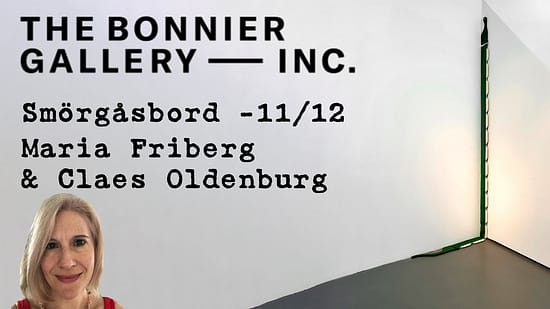
The Bonnier Gallery presents Smörgåsbord, featuring works by Swedish artists Maria Friberg & Claes Oldenburg. The works on view demonstrate the playful ways in which both artists explore representation in their respective mediums. The exhibition will be on view through November 12th, 2022.
String Bean by Claes Oldenburg
Let’s start with String Bean. Pause to consider your personal definition of art. Claes Oldenburg shows you that art can also be an ode to a vegetable. The sculpture is over 14’ in length, most of which stands upright. Although it’s tempting to think of Jack and the Beanstalk when confronted with a green vertical vegetable that is taller than oneself, this one is safely tucked in the corner of the gallery’s walls. Both ends are in plain sight, rather than ascending through the clouds as in the fairytale. The change in scale and the elevation of the subject matter are Oldenburg’s signature artistic and comedic devices. Famous for enormous public sculptures like Spoonbridge and Cherry (1988) and Dropped Cone (2001), Oldenburg delights audiences, especially children. One way a person relates to a sculpture is by unconsciously sizing it up - comparing the object with one’s own size. Children are used to things that tower over them. Oldenburg was connected to his childhood even as an adult, “Everything I do is completely original - I made it up when I was a kid.”
Claes Oldenburg's Tube Supported
The idea that an art object has a physical form that is like a body isn’t lost on artists. Oldenburg identified with a tube of toothpaste, a vessel with its contents spilling out, so much so that at the bottom of a drawing depicting the subject he writes, “Note - projects = myself.” In thinking of the toothpaste sculptures, Oldenburg spoke of the toothpaste works as representations of himself—as an artist who “takes off his cap and oozes out his content.” Notebook Page #3184, Study for Tube Supported by its Contents (1971) is a study for a sculpture Oldenburg would later make in 1983. Two models are also on view, allowing us to catch Oldenburg squeezing out his ideas.
Fanciful things can be sophisticated, too. Oldenburg was a master draftsman. In a drawing called 7-Up Pie, he delineates the side of a slice with a sweep of a pastel. Even String Bean is perfection: its beans are measured, repeated elements (the list of materials for the sculpture declares there are 14 beans) like the geometric segments of many Minimalist sculptures. The bean is a green stripe down the wall, much like the line in Barnett Newman’s painting, Onement 1 (1948), in the Museum of Modern Art in New York. The symmetry is simple yet powerful. Oldenburg extends the line onto the floor, at our feet.
Note: You can find the sculpture Typewriter Eraser, co-created by Claes Oldenburg and Coosje van Bruggen (artist, art historian, and Oldenburg’s wife), outside the Norton Museum of Art in West Palm Beach, FL.
Maria Friberg's Force Majeure
Photography convinces us that something is real. We believe photographs even more than we are willing to believe each other. It’s a perfect medium for Maria Friberg’s Force Majeure series, in which she presents the cityscapes of New York, Miami, Detroit, and San Francisco’s Chinatown. These aren’t skyline shots to hang in your corner office. For each photograph, Friberg crafts everyday objects crafted to imitate a gleaming metropolis. The surfaces of the objects are gorgeous and distinctive, like Northern Renaissance still life painting.
It would be exciting to see one of the photographs from the series on view next to an object from the Wolfsonian - F.I.U. Museum on South Beach. Its specialty is the persuasive power of art and design, focusing on the period of 1850-1950. The museum explores the concept of modernity in relation to social, political, and technological change. Friberg’s staged images of modernist architecture present an ideal. She encourages us to challenge what is real and what we want.
Maria Friberg (b. 1966, Malmö, Sweden) lives and works in Stockholm, Sweden.


